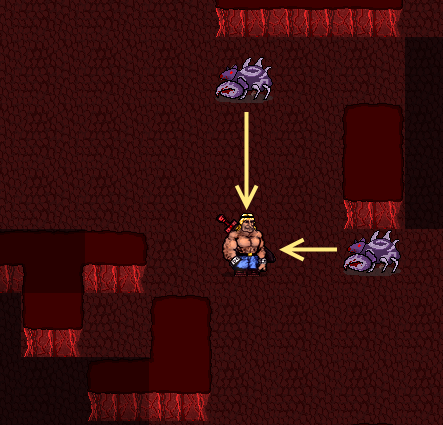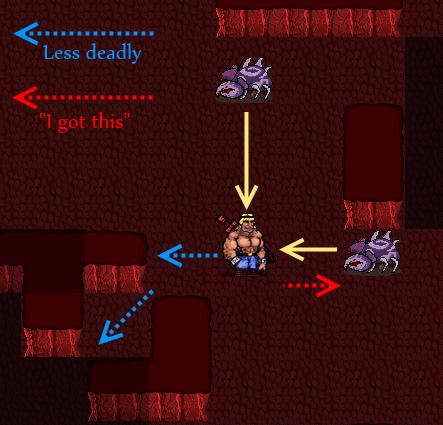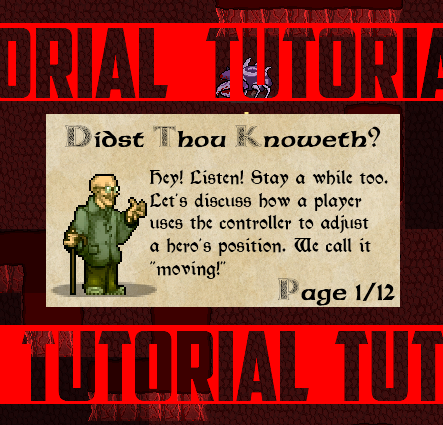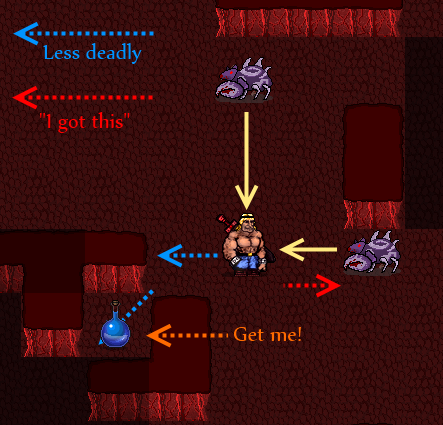As a knee-jerk reaction, when someone uses “balance” and “roguelike” in the same sentence, you get a hardy laugh and a funny look. Roguelikes are dangerous, deadly and unfair! Cheap instant kills, year long stuns, and deadly situations with arcane solutions you can’t possibly figure out without looking them up online. Come on. Well sure, those are the big points the genre might be known for, but when you look past the surface at some of the more polished roguelikes in the field, you’d be surprised what you find.
Games like Crawl use early areas of the game to teach and warm a player up, but never by holding their hand. You can certainly die horribly on the first floor of the dungeon, but you have to be exceptionally careless. Note that careless is different from unlucky, because early on, luck doesn’t factor too much into it. There are plenty of combat situations down the road that can be slaughterfests, but the first floor for a new player should be a good place to learn about the game by playing it. In this case, we want to teach the player how to handle fights against more than one monster. In general:
1) One on one fights against the earliest monsters
* Will be won by the player if he fights using all the abilities of his new hero.
* Can be, and usually are, won by the player if he uses simple melee.
2) Many (2 or more) vs One fights against the earliest monsters
* Can be, and usually are, won by the player if he uses all the abilities of his new hero and positions himself correctly.
* Will probably end in death for the player if he just auto-attacks without regard.
Let’s focus on a many vs one fight. Here’s a situation in which a melee-based green rookie Dungeonmans is facing off against two Dungeon Crab-Rats.

Two on one, the player will probably lose if just choses to stand still and beat them both down. He may have picked up a decent new weapon or might feel courageous with his Shield Bash, and the player is well within his rights to charge ahead– that’s the red path. However, a more cautious player might want to find a location where he can fight his foes one at a time. In most roguelikes, this involves standing in a doorway, but not all dungeons are going to have doorways! That means early areas should have choke points as part of the random generation as seen below.

Since Dungeonmans lets you move in eight directions, stepping between those rock walls and into that space is easy to do. Once done, the player only has to face one rat at a time. The other one will likely run around the back to get him but that gives the player a few rounds to mop up the first one.
Of course a player new to roguelikes might not know they can move into a space like that. Admittedly, it’s not the most intuitive thing. How do we solve this? Easy– a clear, guided, hand-held tutorial on dungeon movement!

Alright joke’s over. No that’s terrible, never do that. A much better idea is to nudge the player without telling him. Give him a reason to try moving into that space even before the monsters show up. Let’s use loot.

Crab-rats or not, when a player sees treasure, they generally want to go pick it up. They’ll try anything to get to a shiny something that appears just out of reach. In this case, it isn’t out of reach at all, but if someone sees this arrangement without realizing they can move diagonally into corners, they’ll discover through sheer force of greed. This means we have a new design rule for our earliest dungeon areas: Build a few chokepoints that have treasure inside them. Encourage the players to move into a position they might not have moved into otherwise, and they’ll learn without realizing it.
That’ll do for now. Any thoughts on the update? Other things you’d like to see more roguelikes try and teach? Please let me know in the comments below, or even via the Facebook or Greenlight pages!

Clever, I really do enjoy these updates. They let me peer into the development corner of Dungeonmans and check out what’s going on behind the curtains and inside your head. I’m sure other players appreciate it as well.